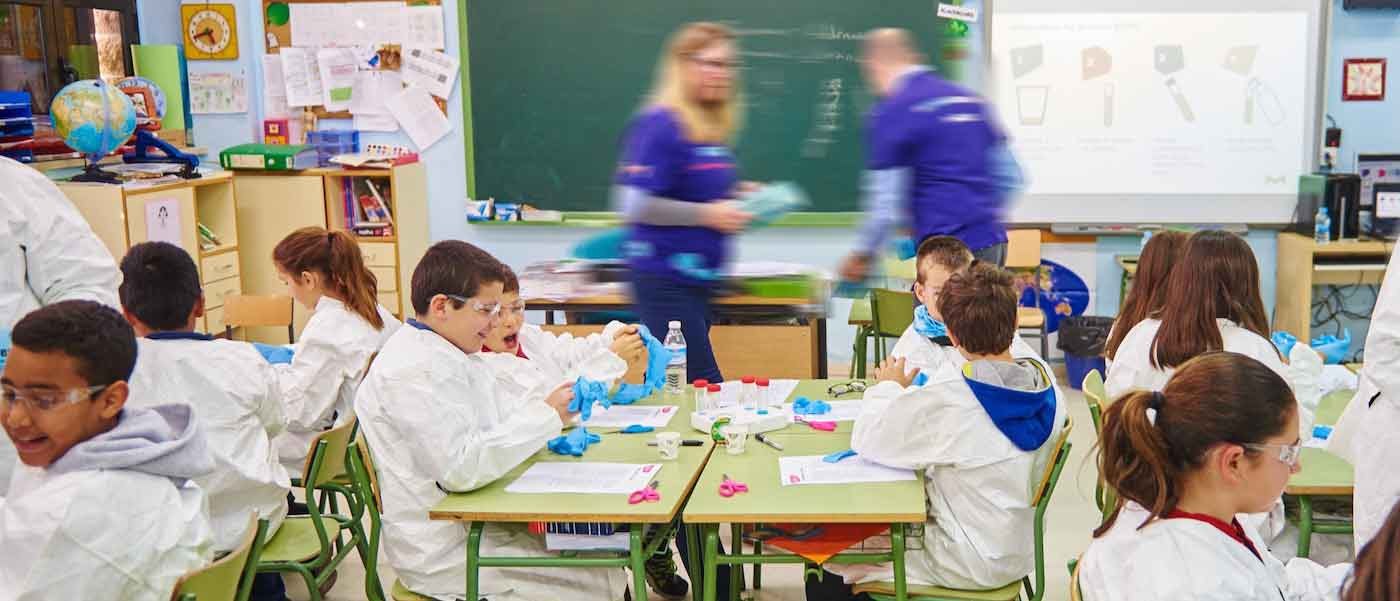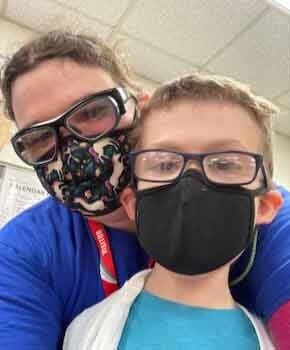Beyond The Bench, Into The Classroom
With sights set on finding someone to eventually take her spot at the bench, a quality control chemist commits to connecting youth with science.

Students participate in a classroom activity with Merck volunteers.
April 17, 2023 | 4 min
A couple of seasoned researchers clean off and tidy the improvised lab benches. The lab is cozy and warm, complete with vibrant bulletin boards and bean bags. A stream of young researchers file in, grab lab coats and put on safety glasses. Today, this third-grade classroom is a science lab.
A handful of Merck employees, including Allison Warn, greet students and orient them to the experiment of the day. Warn, a senior associate quality control (QC) chemist, is deeply passionate about connecting youth with science and regularly volunteers in classrooms and local libraries.
Science education is a key component of SPARK — Merck global volunteer program — and is on full display at the elementary school near the Sheboygan Falls site in Wisconsin, USA. Despite all the makings of a typical volunteer gig, this day feels a little different to Warn.
Sparking curiosity
Curiosity Labs— one of the programs under the SPARK umbrella — educates and inspires students through hands-on, interactive science lessons led by Merck employee volunteers. According to the American Chemical Society, students who engage in hands-on science education develop problem-solving and critical-thinking skills, both vital in the learning process.
“It’s the program I wish I had as a kid but didn’t,” says Warn, who started volunteering right when it launched in 2016.
Scientists are creative and curious. Whether it’s a toddler asking incessant questions about the world or an experienced researcher designing a novel experiment, curiosity is central to science. For third graders, the activity of the day centers around pendulums.
In recent classes, third graders learned the laws of motion, so the activity fit seamlessly. While the application in a grandfather clock no longer resonates with young students, pendulums are critical for various applications, including seismometers. Equipped with pencils, pieces of string and a handful of washers, students make pendulums and experiment with different setups. They tinker with force and motion, bringing textbook descriptions to life.

Students watch pendulums swing from their desks to test hypotheses.
The students study how the swing distance changes given different string lengths and washers. “The kids were fascinated,” says Warn. “It was amazing to watch.”
When Warn was young, she ran a lot of experiments like this. At two, she set her sights on being an astronaut, and, a few years later, a marine biologist. In high school, she took her first chemistry class and from there, she didn’t look back again. She ultimately found her niche as a QC chemist — a role she’s held for over 15 years.
Looking beyond her bench
Working in QC, Warn analyzes and validates products before they ship out to customers. Her department operates across four different labs, conducting a wide variety of tests — from checking melting points to validating molecular structures with nuclear magnetic resonance (NMR) spectroscopy. Most QC chemists train and work in two of the four labs. Given Warn’s tenure, she works in all four.

Allison takes a selfie with her son during an event at his school.
“Someday, curious minds are going to pick up where I left off. I need them to be as enthusiastic as me,” she says. “In order to do that, they need to be shown why science matters, what it can do for them and what it can do for the world.”
She’s already succeeded in this goal. Back in 2016, Warn introduced a group of high school students to chemiluminescence. The activity demystifies how glow sticks work and is a favorite among volunteers and students. Now, one of the students from that group works alongside Warn at the bench.
Back in the third-grade classroom, Warn looks around at the students dismantling their experimental set ups. It’s easy for her to imagine some of them taking similar paths. Experiments wind down and students share some observations. Warn and fellow volunteers pack up supplies and say their goodbyes. One student hurries around the maze of desks and quickly embraces Warn.
This day was different from all the others because, on this day, that student was her kid. “Thanks, mom!” he says, with a brimming smile.
Maybe he'll follow in her footsteps to the bench. Maybe not. But, for Warn, and so many other employee volunteers, bringing hands-on STEM education to young students is worth it if just one walks away with a spark of newfound curiosity.
"Someday, curious minds are going to pick up where I left off. I need them to be as enthusiastic as me." - Allison Warn
About SPARK
We are committed to accelerating access to health for people everywhere while also sparking curiosity in the next generation of scientists. We support these efforts both through philanthropic investments and by channeling the diverse talents, expertise and passion of our employees. Through SPARK, employees with a wide array of backgrounds — including chemists, communicators, lawyers and machinists— volunteer in their communities. Employees give back by volunteering for hands-on science activities, beach clean ups and meal packing events, among other activities.
Through Curiosity Labs, Curiosity Labs at Home, and the Curiosity Cube, we bring hands-on, interactive science lessons to students around the world. In 2022, through SPARK, the company reached more than 43,000 students across 532 events in 28 countries. Employees —1,733 to be exact — collectively spent 15,358 hours sparking a curiosity for science! Learn more
Para seguir leyendo, inicie sesión o cree una cuenta.
¿No tiene una cuenta?